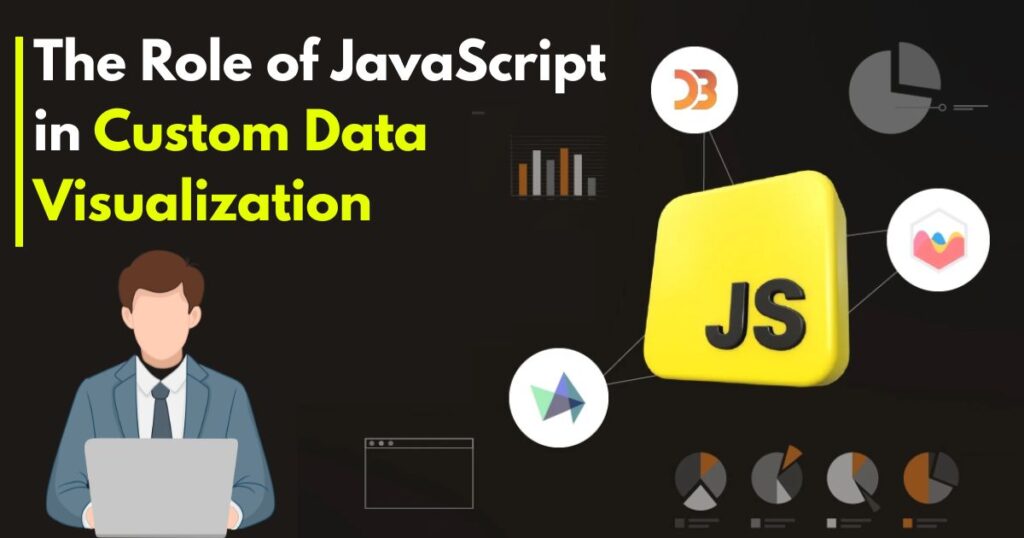Data visualization has become a crucial part of decision-making across industries. According to a 2024 study by Gartner, 70% of business leaders believe visual analytics significantly improved their decision-making capabilities. Another report by Statista notes that the data visualization software market is projected to reach $11.6 billion by 2026.
Organizations rely on Data Visualization Consulting Services to develop custom solutions tailored to their data needs. JavaScript plays a central role in this process, offering libraries and frameworks that allow developers to create responsive, interactive, and scalable visualizations. JavaScript-based solutions are widely adopted due to their browser compatibility, real-time data handling, and extensive ecosystem.
This article explores the technical role JavaScript plays in building custom data visualizations. It explains the strengths, challenges, and real-world applications of this language in visualization projects.
Why JavaScript is Ideal for Data Visualization
JavaScript is native to web browsers. This makes it an ideal language for interactive visualizations that work across platforms without additional plugins. Here are several reasons why JavaScript is preferred:
- Cross-platform support: Works seamlessly across all modern browsers.
- Dynamic interaction: Enables real-time updates and responsive elements.
- Extensive ecosystem: Offers a wide range of libraries and tools.
- Strong community support: Numerous forums, documentation, and active contributors.
These features provide a flexible foundation for developers offering Data Visualization Consulting Services to build tailored and user-friendly dashboards.
Core JavaScript Libraries for Data Visualization
Several libraries have become standard in custom data visualization projects:
1. D3.js (Data-Driven Documents)
- Offers granular control over every visual element.
- Uses SVG, HTML, and CSS to create complex visuals.
- Supports custom transitions and animations.
- Commonly used for statistical graphics and dynamic charts.
2. Chart.js
- Lightweight and beginner-friendly.
- Includes built-in support for common chart types.
- Ideal for small-scale visual dashboards.
3. Three.js
- Renders 3D graphics using WebGL.
- Used for complex scientific and spatial data visualizations.
4. Highcharts
- Commercial library with professional support.
- Includes export features and data modules.
5. Plotly.js
- Built on D3 and stack.gl.
- Enables interactive and collaborative visualizations.
Each library has its own use case. D3.js is often the top choice in Data Visualization Consulting Services for its high level of customization.
Real-World Use Cases
JavaScript-based visualization is employed across industries. Below are real-world examples of custom implementations:
Healthcare
- Example: A hospital dashboard showing patient inflow, bed occupancy, and lab results.
- Technology: D3.js for charts, real-time API for data feeds.
Finance
- Example: Stock market performance and live trading indicators.
- Technology: Plotly.js and WebSocket for live updates.
Manufacturing
- Example: Visual tracking of supply chain bottlenecks.
- Technology: Highcharts with REST API integration.
Education
- Example: Student performance dashboards.
- Technology: Chart.js integrated with backend learning platforms.
These examples demonstrate the adaptability and utility of JavaScript in different domains.
Technical Workflow for Custom Visualization Projects
Building a custom solution involves a structured approach:
1. Data Preparation
- Format and clean raw data.
- Remove inconsistencies and handle missing values.
2. Tool Selection
- Choose appropriate JavaScript library.
- Match tool to the complexity and type of data.
3. Development
- Create responsive layouts using HTML and CSS.
- Render visuals using chosen JavaScript library.
- Integrate animations or transitions.
4. Integration
- Connect to backend APIs.
- Ensure data sync and interactivity.
5. Testing and Deployment
- Cross-browser testing.
- Optimize for performance and accessibility.
Following this pipeline ensures maintainability and scalability of visual solutions.
Performance Considerations
Performance optimization is critical for real-time and large-scale visualizations. JavaScript developers must address:
- Rendering efficiency: Use Canvas or WebGL for complex visuals.
- Memory management: Remove unused DOM elements.
- Data handling: Apply pagination or lazy loading for large datasets.
- Responsiveness: Use throttling and debouncing for event handling.
Proper performance tuning improves load times and enhances user experience.
Security and Data Privacy
When building with JavaScript, it’s essential to follow security best practices:
- Input validation: Prevent cross-site scripting (XSS).
- Authentication: Secure data endpoints.
- Obfuscation: Protect proprietary code and logic.
Security becomes even more critical when visualizations include sensitive business or user data.
Challenges in JavaScript-Based Visualization
Despite its benefits, JavaScript visualization presents several challenges:
- Steep learning curve with libraries like D3.js.
- Browser compatibility issues with complex graphics.
- Debugging difficulties in asynchronous data flows.
- Performance bottlenecks for massive datasets.
Experienced teams offering Data Visualization Consulting Services mitigate these challenges using best practices and thorough planning.
Comparing JavaScript to Other Visualization Tools
Below is a comparison of JavaScript versus other tools:
|
Feature |
JavaScript (D3, Chart.js) |
Tableau |
Power BI |
|
Customization |
High |
Medium |
Low |
|
Interactivity |
High |
Medium |
Medium |
|
Cost |
Mostly Free |
Paid |
Paid |
|
Integration Flexibility |
High |
Limited |
Moderate |
|
Developer Skills Required |
High |
Low |
Low |
JavaScript offers more freedom at the cost of requiring technical expertise.
Future Outlook
The trend toward real-time, browser-based analytics continues to grow. JavaScript libraries are constantly evolving. Recent advancements include:
- WebAssembly support for better performance.
- AI integration to automate chart suggestions.
- Augmented reality (AR) visualizations for spatial data.
These developments ensure JavaScript remains a key player in custom data solutions.
Conclusion
JavaScript plays a vital role in custom data visualization. Its flexibility, interactivity, and ecosystem make it ideal for crafting tailored solutions. Whether it’s building real-time dashboards or complex 3D graphics, JavaScript enables precise control over design and function.
Organizations seeking to visualize complex datasets effectively rely on expert Data Visualization Consulting Services that leverage JavaScript’s full capabilities. As the demand for interactive, real-time data continues to grow, so does the importance of JavaScript in the data visualization landscape.
Frequently Asked Questions (FAQs)
1. Why is JavaScript preferred over other languages for custom data visualization?
JavaScript is native to all modern browsers, making it inherently cross-platform without the need for additional plugins. It supports dynamic interactions, real-time data manipulation, and is backed by a rich ecosystem of libraries like D3.js, Chart.js, and Plotly.js. Its flexibility allows developers to create fully customized, interactive visualizations that adapt to various industry needs, from finance to healthcare.
2. What are the most commonly used JavaScript libraries for data visualization, and how do they differ?
- D3.js: Offers deep customization and control, ideal for complex and highly tailored visuals.
- Chart.js: Simple and lightweight, best for quick setups and basic dashboard needs.
- Three.js: Used for rendering 3D visuals, especially in spatial or scientific data.
- Highcharts: A commercial solution with built-in modules and export options.
- Plotly.js: Combines D3 with stack.gl for interactive, collaborative dashboards.
Each library serves different use cases, allowing developers to choose based on complexity, performance, and project needs.
3. What are the main challenges of using JavaScript for data visualization?
Some common challenges include:
- Steep learning curve with powerful libraries like D3.js.
- Browser compatibility issues, especially with advanced graphics or animations.
- Performance bottlenecks when handling large-scale or real-time datasets.
- Debugging complexities in asynchronous data flows or integrated backends.
Overcoming these challenges requires a strong understanding of front-end development and best practices in visualization architecture.
4. How do JavaScript-based visualizations ensure performance and scalability?
Performance is optimized through:
- Using Canvas or WebGL instead of SVG for large datasets.
- Implementing lazy loading and data pagination to handle big data.
- Applying throttling and debouncing for smooth user interactions.
- Efficient DOM and memory management to avoid lag and memory leaks.
These practices help maintain responsive and smooth experiences, even with complex or live-updating visualizations.
5. How secure are JavaScript-based visualization applications?
Security is a key concern, especially when dealing with sensitive or proprietary data. Best practices include:
- Input validation and output sanitization to prevent XSS attacks.
- Implementing authentication and authorization layers for secure data access.
- Code obfuscation and minification to protect business logic.
- Using HTTPS and secure WebSocket connections for data transmission.
When developed by experienced teams, JavaScript visualizations can be both secure and compliant with modern data privacy standards.
- JavaScript in Custom Data Visualization | Build Interactive & Scalable Dashboards
- Discover how JavaScript powers custom data visualizations with dynamic, interactive, and scalable solutions. Elevate your analytics with expert consulting services.
- JavaScript data visualization, custom data visualization, data visualization consulting services, D3.js, Chart.js, interactive dashboards, web-based visualizations, real-time data visualization, JavaScript libraries, scalable data visualizations
Related posts:
 Why KBH Games Is Perfect for Family-Friendly Online Entertainment
Why KBH Games Is Perfect for Family-Friendly Online Entertainment
 Build a Seamless School Portal with These Powerful Templates
Build a Seamless School Portal with These Powerful Templates
 7 Ways Aerospace Companies Are Using Composites to Elevate Aerial Robotics
7 Ways Aerospace Companies Are Using Composites to Elevate Aerial Robotics
 Samsung Galaxy S24 Ultra Price in Pakistan: A Closer Look at the Mid-Range Marvel
Samsung Galaxy S24 Ultra Price in Pakistan: A Closer Look at the Mid-Range Marvel
 The Ultimate Web Development Checklist for Building High-Performance Digital Experiences
The Ultimate Web Development Checklist for Building High-Performance Digital Experiences
 10 Local SEO Tips to Boost Your Electronics Repair Shop Online
10 Local SEO Tips to Boost Your Electronics Repair Shop Online
 Optimizing Healthcare Operations in Qatar Through Dynamics 365 Finance and Operations
Optimizing Healthcare Operations in Qatar Through Dynamics 365 Finance and Operations
 How Real-Time Monitoring and MES Modernization Are Revolutionizing Manufacturing
How Real-Time Monitoring and MES Modernization Are Revolutionizing Manufacturing







